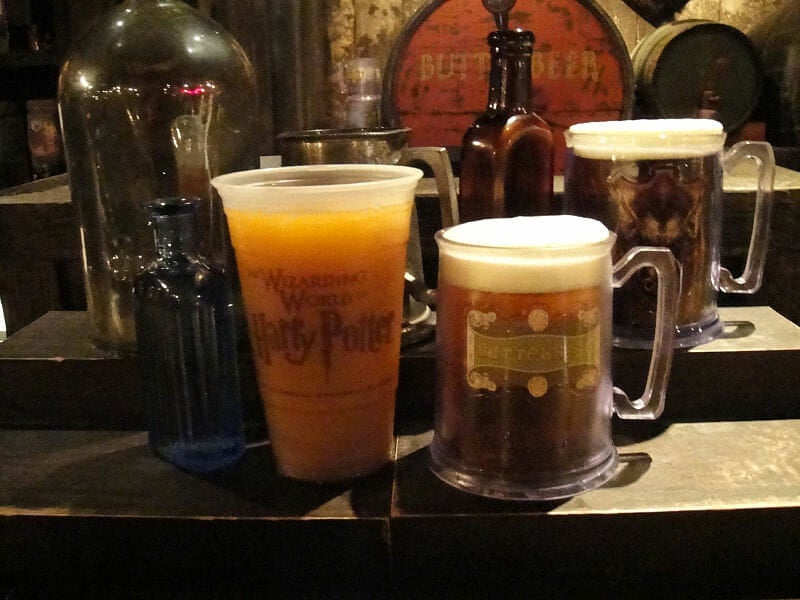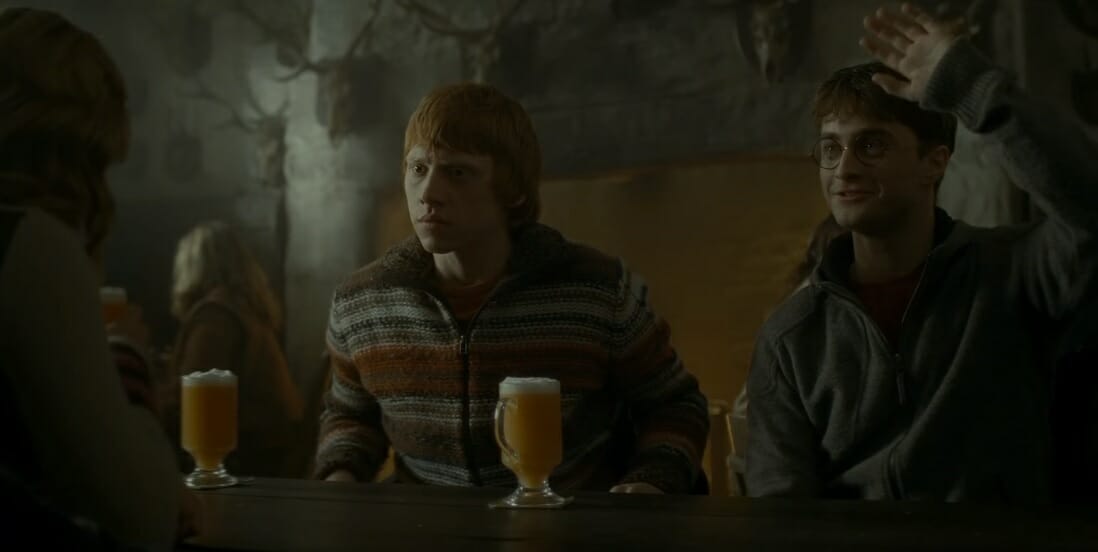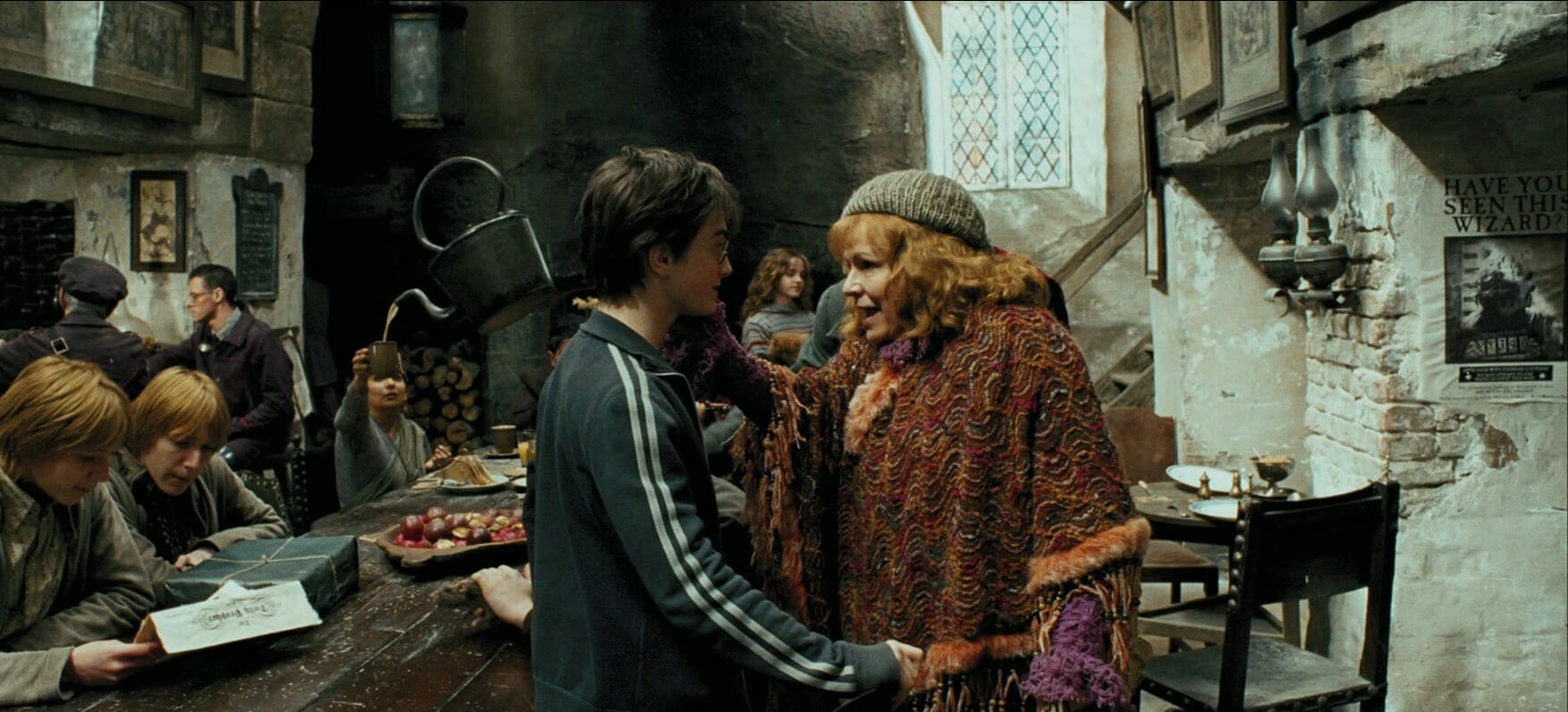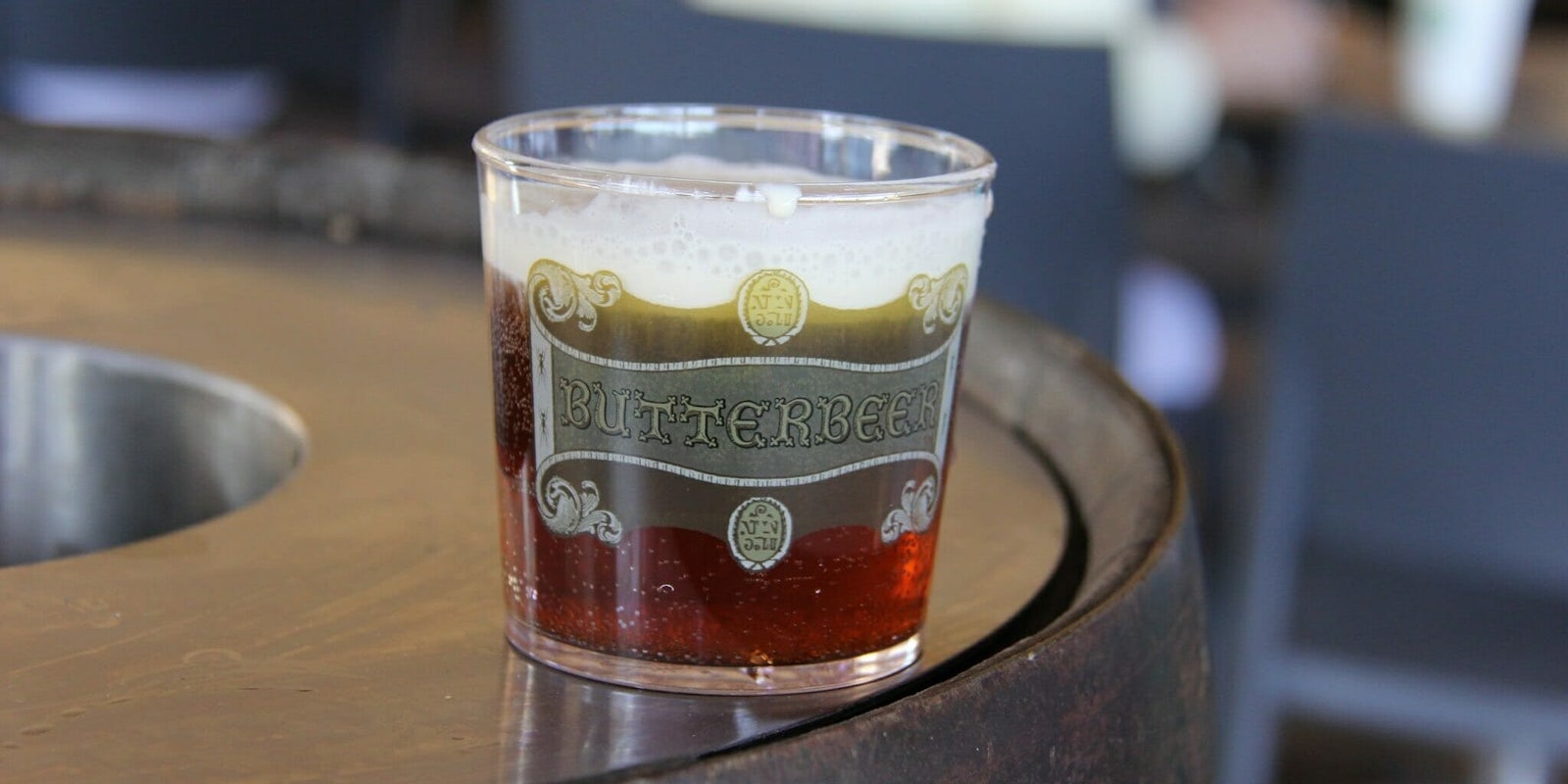Butterbeer is a staple drink in the Wizarding World, and a predictably a popular choice for Harry Potter theme parties. But when making your own Butterbeer, fans must deal with a couple of tricky questions: Is Butterbeer alcoholic, and what does it actually taste like?
Thanks to the connotations of underage drinking, that first question is pretty divisive. You might assume that Harry and his 13-year-old pals can’t possibly be drinking alcohol, but since when did wizards care about health and safety? To get to the bottom of this mystery, we’ve combed Harry Potter canon for evidence of Butterbeer’s booziness—or lack thereof.
What is Butterbeer?
The word “Butterbeer” brings to mind something comforting and warm, but the books don’t specify what it’s made of. It arrives in chilled bottles or in warm, foaming tankards at pubs, and it’s popular among teenagers. However, the flavor is mostly left to the imagination. This resulted in something like the Turkish delight effect of the Narnia books, where kids tend to imagine Turkish delight as their favorite candy if they haven’t tasted it IRL.
There’s a real historical drink called buttered beer, with a few recipes surviving from Tudor England. It’s a kind of spiced eggnog/beer combo with melted butter, but that’s probably not what J.K. Rowling envisioned. She personally imagined Butterbeer as having a butterscotch flavor, and that’s a prevailing theme in real-world recipes. If you go to the Harry Potter theme park in Florida, you can get hot and cold Butterbeer drinks that taste of butterscotch and shortbread.

There’s also Butterbeer ice cream and a range of fanmade recipes with ingredients like condensed milk, cream soda, and whipped cream. Most of them are nonalcoholic because Harry Potter is aimed at kids, but that may not reflect the “real” Butterbeer of the books. In fact, there’s strong evidence that Butterbeer can get you drunk. Yes, even though it’s sold to 13-year-olds.
Is Butterbeer alcoholic?
In the sixth movie, we see Hermione acting a little tipsy after drinking a few Butterbeers in Hogsmeade. That makes things pretty clear within the movie franchise, but for book purists, we must turn to Winky the house elf.

After getting fired by the Crouch family and joining the Hogwarts domestic staff, Winky gets depressed and develops a Butterbeer habit. She’s intoxicated throughout Harry Potter and the Goblet of Fire, and while it’s possible that Butterbeer only has this effect on house elves, there’s one scene that strongly implies Butterbeer just has a low alcohol content. Specifically, Harry points out that it’s “not that strong.”
She was clutching a bottle of Butterbeer and swaying slightly on her stool, staring into the fire. As they watched her, she gave an enormous hiccough.
‘Winky is getting through six bottles a day now,’ Dobby whispered to Harry.
‘Well, it’s not strong, that stuff,’ Harry said.
But Dobby shook his head. ‘’Tis strong for a house-elf, sir,’ he said.
House elves are much smaller than humans, so you can imagine one getting drunk on six bottles. Meanwhile, a tankard or two would have minimal impact on a human teenager.
Two books later, Harry speculates about what might happen “under the influence of Butterbeer” at Professor Slughorn’s party, further suggesting that it’s slightly alcoholic. This all adds up to Butterbeer being something like shandy, maybe 1-2% alcohol compared to the 4-6% of a typical British beer.
Some of the assumptions about Butterbeer may be down to cultural differences. In 2009, the New York Times published an article voicing concerns about the depiction of alcohol in the Potter franchise. Aside from the fact that plenty of children’s movies include drunkenness (remember Pirates of the Caribbean?), Harry Potter reflects a lot of British cultural norms. If we imagine the Wizarding World as a close-knit community like a rural town, it’s realistic to see teenagers in the local pub. Kind of like this scene in Hot Fuzz, where big-city cop Simon Pegg shocks the villagers by asking underage drinkers for ID. Locations like the Three Broomsticks suggest a culture where teenagers can visit a pub while surrounded by adults from the same community. And remember, the Leaky Cauldron is the first place any 11-year-old muggleborn visits when they arrive in Wizarding London.

There are occasional references to rebellious teens like the Weasley twins or Seamus Finnigan smuggling Firewhisky into Hogwarts, but in general, the Potter books have a healthier attitude to alcohol than your average binge-drinking party scene in a teen movie.
Magical booze culture ties into the books’ quasi-historical setting. With a Dickensian fantasy aesthetic and an absence of modern muggle technology, Harry’s adventures don’t feel like they take place in the 1990s. Everyone eats traditional British fare like roast dinners and treacle pudding, and the alcoholic drinks are like something from a historical drama. Wizards drink mead, whiskey, brandy, and beer, but nary a vodka tonic in sight. Even the wine sounds like something from Shakespeare or Tolkien, with references to elderflower wine, nettle wine, and wine made by elves.
READ MORE:
- 13 things you don’t know about Severus Snape
- 15 dark facts about Draco Malfoy
- Harry Potter prequel fan movie ‘Voldemort: Origins of the Heir’ hits YouTube
This vaguely historical atmosphere makes it feel more natural for kids to be drinking “underage.” Up until the 19th century, it was normal for everyone—including young children—to drink “small beer” all day, because water was unsafe. And while Butterbeer is obviously about being drunk for pleasure instead of practicality, it falls into a similar category. It’s weak enough that many readers don’t even consider that it might be alcoholic.
These days, the legal age to purchase alcohol in Britain is 18, with 16 and 17-year-olds allowed to drink beer, wine or cider if bought by an adult with a meal. (In other words, the typical scenario for a pub lunch in Hogsmeade.) At home, anyone over the age of five can drink alcohol—implicitly with adult supervision. Since witches and wizards become legal adults at 17, it’s no great stretch to imagine them drinking slightly alcoholic Butterbeer in their early teens. Especially since they’re exposed to much more dangerous substances at school.
Correction: Winky the house elf was employed by the Crouch family, not the Malfoys.


